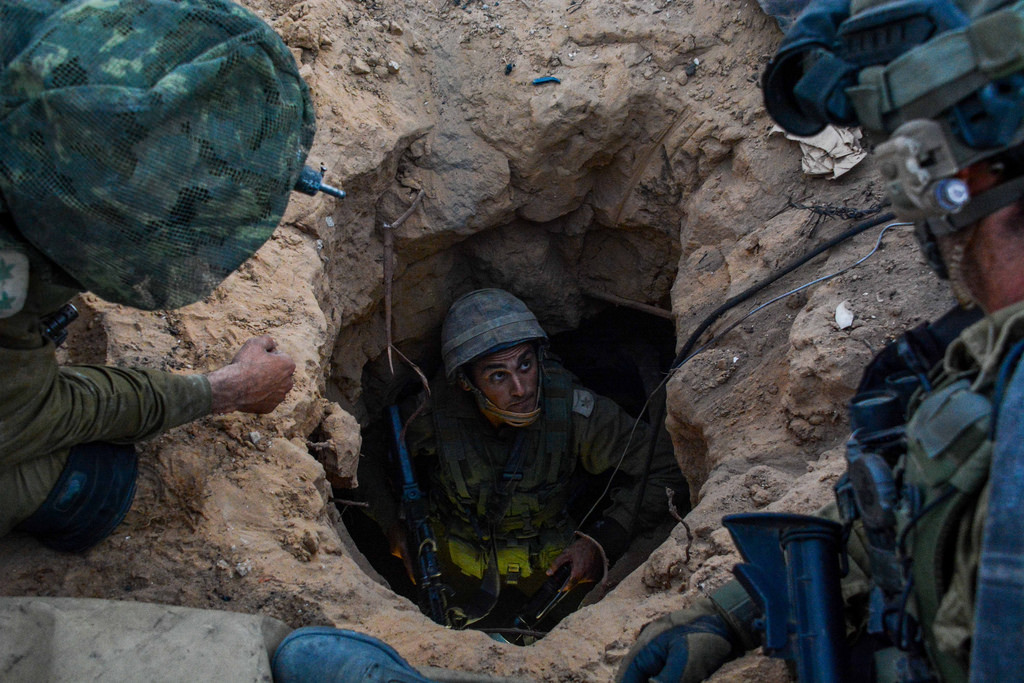The IDF MAG’s Gaza Report and Its Critics: Context, Compliance, and Credibility
“No plan survives first contact with the enemy.” This axiom informs compliance with the law of armed conflict (LOAC) in combined arms maneuver: combat operations involving ground forces employing a range of capabilities to achieve an overarching “commander’s intent.” Ground maneuver combat is decentralized and dynamic, especially when dealing with an agile and adaptable enemy. LOAC’s application will often turn on factors such as available capabilities, the enemy’s strength and tactics, time for deliberation, and the speed of maneuver.

Published by The Lawfare Institute
in Cooperation With

“No plan survives first contact with the enemy.” This axiom informs compliance with the law of armed conflict (LOAC) in combined arms maneuver: combat operations involving ground forces employing a range of capabilities to achieve an overarching “commander’s intent.” Ground maneuver combat is decentralized and dynamic, especially when dealing with an agile and adaptable enemy. LOAC’s application will often turn on factors such as available capabilities, the enemy’s strength and tactics, time for deliberation, and the speed of maneuver. In short, when assessing LOAC compliance, context matters.
This contextual understanding is especially relevant to a balanced assessment of the latest report from the Military Advocate General (MAG) of the Israeli Defense Force (IDF) on a major combined arms operation during the 2014 Gaza conflict, known as Operation Protective Edge. The context of the Gaza operation received insufficient weight in critical commentary on the MAG report by our respected colleagues Amichai Cohen and Yuval Shany.
While we recognize that reasonable minds can differ in such assessments, we believe the MAG report provides an important opportunity to highlight the importance of operational context. Indeed, the report is praiseworthy for its comprehensiveness and its modeling of a critical inquiry that will spur improvements in tactics, techniques and procedures of future operations.
The Operational Context of the IDF’s 2014 Operation Protective Edge in Gaza
The distinctive nature of combined arms maneuver operations frames LOAC’s implementation. (One of us, Corn, has commented on the issue here.) During Operation Protective Edge, the IDF confronted a rapidly evolving threat by Hamas and other organized armed groups in Gaza. While the operation initially focused on neutralizing the threat to Israel posed by Hamas rockets and mortars, the IDF’s discovery of an elaborate network of Hamas cross-border assault tunnels necessitated a dramatic operational shift. (For more on the growing role of tunnels in modern warfare, see Jonathan Cedarbaum’s review of a fascinating new book by Daphne Richemond-Barak.)
Sophisticated in construction and difficult to detect, these tunnels enabled Hamas raids into Israel to capture or kill IDF personnel and civilians living close to the border. Israel launched a major ground force incursion into Gaza to neutralize this infiltration threat, which required discovery of tunnels’ entry and exit points and their intersection with other nodes in the network. Hamas, for its part, fully recognized that the tunnels were a potential strategic game-changer, and tasked its military operatives with blocking or at least delaying the IDF’s anti-tunnel efforts. Unfortunately for both the IDF and the Gaza civilian population, this meant close combat in densely populated areas. Eventually, Israel and Hamas agreed to a ceasefire.
End of the Ceasefire and Hamas Operatives’ Capture of IDF Lieutenant Hadar Goldin
But the pause in hostilities was short-lived. Hamas operatives soon ambushed IDF ground forces in the Gazan town of Rafah and captured an IDF soldier, Lieutenant Hadar Goldin. The lieutenant’s repatriation became a high-priority task for the IDF forces near Rafah. However, this was only one among a number of mission-essential tasks for the IDF, which included eliminating the cross-border tunnels; targeting Hamas command, control and communications; and destroying or degrading other Hamas military infrastructure.
To achieve these goals, the IDF launched a combined arms effort. This operation and the sequences of incidents that it spawned became the primary focus of the MAG’s investigative report.
Believing Hamas was attempting to transport Goldin to a secure location, the IDF employed a wide range of combat power to disrupt Hamas operations and repatriate the captured lieutenant. That response involved sustained air, mortar and artillery fires to block off the escape route of Goldin’s captors, neutralize other enemy assets and efforts, and prevent or disrupt Hamas attacks on IDF forces engaged in the operation. Though Goldin died of his wounds before Hamas operatives could bring him behind their lines, IDF commanders did not know this when they launched these attacks. According to the MAG, aerial attacks serving these purposes resulted in the deaths of 42 Gazan military operatives, along with the deaths of 72 persons whom the MAG report assumes to have been civilians.
The Distorting Effect of Comparing a Narrow View of Military Advantage With Aggregate Civilian Deaths Across Many Operations
All civilian casualties in war are tragic, and commanders should always seek to mitigate the risk of such suffering. But focusing on aggregate ratios has the effect of obscuring, not illuminating, issues of LOAC compliance in a complex combined arms mission.
In their criticism of the MAG report, our colleagues Amichai Cohen and Yuval Shany cite aggregate civilian deaths in the course of the IDF’s Rafah operations to argue that the IDF may have violated the LOAC rule of proportionality, which prohibits any attack in which a commander anticipates that the harm to civilians and/or civilian objects will be excessive compared to the anticipated concrete and direct military advantage. However, Cohen and Shany are imprecise in defining the military advantage that the IDF anticipated in each of its Rafah operations. They characterize the relevant military advantage anticipated by the IDF’s Rafah operations as either “sav[ing] one soldier from being abducted” or “protect[ing] the lives of IDF soldiers who quickly responded to the abduction.” But this formulation discounts the full operational context of the IDF’s actions.
As the MAG report makes clear, once the ceasefire with Hamas ended, the IDF also resumed its efforts to attack Hamas military operatives—including senior commanders—and neutralize military infrastructure. The IDF’s anticipated military advantage included achievement of these goals, along with thwarting Goldin’s abduction and protecting IDF personnel. A correct proportionality calculation adds the anticipated outcomes of neutralizing Hamas military personnel and infrastructure to the military advantage side of the ledger, raising the bar regarding what level of anticipated civilian harm is considered “excessive”: The anticipated gain of greater military advantage balances out greater anticipated civilian harm. Cohen and Shany’s omission of the twin goals of attacking Hamas combatants and neutralizing their infrastructure thus distorts the proportionality calculus.
Context Matters
This contextual approach sheds light on IDF critics’ accusations. Some critics of the IDF have argued that the death toll in Rafah and elsewhere was a product of indiscriminate use of artillery, tank and mortar fire, as well as aerial attacks. Cohen and Shany are more balanced in this respect. As they acknowledge, the MAG report actually indicates that the use of artillery, tank and mortar fires was far more tailored than the critics claim. The IDF’s measured response is particularly impressive because lower levels of command coordinated these fires in time-sensitive situations to support troops in contact with enemy forces.
The MAG reports that tanks attacked military targets based on intelligence data and the assessments of field commanders. Moreover, IDF tanks fired approximately 140 total shells—not an extraordinarily large number, given the fierce fighting around southeast Rafah. According to the MAG, aerial attacks targeted military objectives, including a senior enemy commander, other military infrastructure and exit points for the cross-border tunnels. These military objectives included the Rafah intersections based on the assessment that this location itself qualified as a military objective, as an attack would disrupt Goldin’s captors and interdict Hamas forces massing to attack the IDF’s ground advance. Aerial attacks flowed from earlier findings that few civilians were visible and at risk at those coordinates.
Cohen and Shany assert that the IDF should have undertaken more “advance planning,” rather than engage in an “emergency response” after the ceasefire’s end (see the paragraph just above the two bullet points near the end of their section on “Military Advantage and Proportionality”). Here, Cohen and Shany fail to account for the unpredictable nature of combined arms ground operations against an adaptive and effective enemy like Hamas. As is often lamented during combat operations, the enemy “gets a vote.” It is unrealistic to require a commander to effectively anticipate every pivot-point resulting from enemy action. State forces must respond to this “enemy vote” in a way that retains tactical and operational initiative, advances the ultimate objectives of the mission and complies with all legal obligations.
Furthermore, Cohen and Shany overlook the fact that Hamas operatives seized Goldin in the midst of an evolving ground operation, which the IDF had hoped to avoid but was itself an exigent response to the unexpected but deadly threat of cross-border tunnels. Once IDF commanders received word of the ambush and capture, it was reasonable for them to assess time as a decisive operational consideration: delaying the response would cede advantage to the enemy and negate the military advantage anticipated by the IDF. While the MAG report acknowledges that the exigencies of the moment obliged the IDF to start its operation “without sufficient preparation,” one must ponder how much preparation was realistically possible at that moment. Compliance with LOAC requires reasonable decisions in the circumstances ruling “at the time”—which includes the “time” in which those decisions must be made.
Operation Protective Edge and the LOAC Rule of Precautions in Attack
Perhaps the most important LOAC rule for analyzing IDF actions during the 2014 Gaza incursion is the rule of precautions in attack, which requires the attacker to take all “feasible” efforts to reduce harm to civilian persons or objects. Under both customary international law and Additional Protocol I of the Geneva Convention, this duty is part of the attackers’ duty of “constant care” to mitigate civilian risk. However, this obligation is not unbounded. Cohen and Shany question whether the IDF’s actions after the end of the ceasefire entailed “undertaking all possible precautions” (emphasis added; see the first of the two bullet points at the end of the “Military Advantage and Proportionality” section). However, the rule of precautions in attack does not require all possible measures, which would paralyze commanders. Instead, the feasibility qualifier indicates that commanders should be held to a standard of reason and common sense, requiring only what is tactically and operationally practicable under the circumstances, including resource constraints, technological limits and operational concerns.
Cohen and Shany take up the issue of precautions in connection with the IDF’s use of warnings to alert civilians that their location might come under fire. The MAG report details copious IDF efforts throughout the 2014 Gaza campaign to provide general warnings to the civilian population, including telephone messages, television and radio announcements, and individual phone communications with “key figures” in particular communities. Nevertheless, Cohen and Shany fault the IDF for not providing specific warnings to civilians immediately before an attack—but the MAG report asserts that such specific warnings can undermine operational goals by tipping off defenders that an attack is imminent, enabling the defending force to evade the attack or better prepare a defense.
This is one of the most common examples of the valid application of the feasibility qualifier to the warning obligation. Given the dynamic nature of armed conflict, a specific warning under such circumstances would erase an attacker’s military advantage. Such a forfeiture of military advantage is simply not required under the rule of precautions.
The Effect of Hamas’s Persistent Disregard of Defender’s Duties
Another salient aspect of the dynamic context in Gaza involves Hamas’s persistent efforts to mingle its military infrastructure with civilian residences. This technique—a staple of terrorist organizations such as Hamas—is a clear violation of “defenders’ duties” under LOAC to distinguish their forces from civilians and take feasible measure to prevent harm to civilians under the defenders’ control (see Eric Jensen’s article here and Corn’s here ). Time and time again, the MAG report documents how Hamas implanted commanders, combatants and infrastructure in putatively civilian structures. Cohen and Shany allude to this Hamas tactic in the first paragraph of their section on “Warnings, Intelligence and Criminal Proceedings.” Of course, utilizing a civilian structure for military purposes and thus transforming it into a military objective is neither unlawful nor uncommon. But Hamas did more than just occupy civilian buildings; it routinely used buildings that were occupied by civilians, making no effort to evacuate these civilians and even seeking to hinder such evacuation. In so doing, Hamas crossed a line from legitimate tactics to an illicit effort to exploit the presence of civilians to shield Hamas assets from attack.
That illicit tactic ensures that the defending organization wins in some vector of the conflict. Either the attacker stays its hand, ceding critical tactical initiative to the enemy, or else the defender reaps a propaganda victory when attacks on its military assets also harm civilians. While that ongoing violation of LOAC by groups such as Hamas does not relieve an attacker like the IDF of the duty to take all feasible measures to mitigate the risk the enemy seeks to exacerbate, a defenders’ willful violation of its own obligation to take “constant care” to mitigate risk to civilians is relevant to the reasonableness of an attack decision.
Precautions and Technology in the Gaza 2014 Campaign
Another issue under the rule of precautions in attack not addressed by Cohen and Shany concerns the inherently dynamic role of technology. The rule of precautions does not require adoption of the most up-to-date technology for every attack, which would not be practicable or feasible for states with varying technological capabilities. Moreover, given the dynamic nature of armed conflict, even a technologically advanced state may need to carefully budget its most sophisticated munitions to ensure their availability for future engagements (see Mike Schmitt’s article here).
Nevertheless, when use of more advanced technology in an attack is feasible and would demonstrably reduce harm to civilians, the rule of precautions in attack requires its use (see Margulies’s article on precautions, autonomous systems, and artificial intelligence here). But there is no credible basis for concluding that anything other than valid operational constraints resulted in decisions to forego precision attack weapons during Operation Protective Edge.
The MAG report provides indications that the IDF has continued to update the technology it deploys, based in part on “lessons learned” from the 2014 Gaza incursion. Consider an incident not mentioned by Cohen and Shany in which an errant mortar strike on nearby Hamas forces killed as many as 15 persons at a United Nations school in Beit Hanoun. IDF forces in the area were seeking to locate and destroy a cross-border tunnel and came under heavy fire from Hamas operatives located near the school. The MAG report notes that the IDF was aware that civilians had massed at the school for shelter from the surrounding carnage. Unfortunately, the intensity of the fighting made an evacuation of the school difficult.
To quell incoming fire from Hamas operatives, IDF forces directed mortar fire at a spot identified visually as the operatives’ location. According to the MAG report, the IDF used a single mortar aimed at an area approximately 130 meters from the school—a distance the report describes as “significantly greater” than the designated “safety margin” for this particular weapon. Unfortunately, three of the shells landed on the school’s grounds, killing approximately 15 persons and wounding scores more. The MAG determined, after a long and thorough investigation, that criminal charges were not appropriate in this case. However, the report notes that the IDF implemented “operational lessons-learned” to reduce the risk of future incidents.
Distinguishing Between Tactical Errors and Criminally Culpable Decisions
The MAG report’s assessment of the Beit Hanoun incident, in which the IDF employed mortar fires in the vicinity of a school, merits special attention. Some might consider a criminal indictment the only appropriate response to IDF actions in relation to this incident. After exhaustive investigation, the MAG did not choose this outcome. The MAG’s decision was reasonable, given the information recounted in the report.
The use of mortars in densely populated areas requires great care. And it is true that the inherent risk of collateral damage associated with mortar fires in such close proximity to civilians and civilian property raises legitimate concerns. Nevertheless, mortars are the only fire-support capability routinely located within ground maneuver units, and as a result are most accessible for time-sensitive fire-support requirements. In an urban environment, these requirements will often include suppression or disruption of enemy attacks on friendly forces attempting to maneuver through areas ripe for ambush.
Ultimately, however, even the premise that this attack decision was unwise, or that in retrospect greater caution or different options may have been preferable, does not necessarily compel a conclusion that the available information warrants criminal referral. Criminal action, unlike administrative measures taken to improve tactical judgments in the future, requires more than a conclusion that a tactical judgment was unwise; it requires proof beyond a reasonable doubt of recklessness. This is no easy burden to satisfy, especially in the chaos of time-sensitive, decentralized attack decisions. Again, considering the nature of the weapon system without considering the full context of tactical employment produces a distorted picture of compliance.
Specifically, in this case, there were other factors that provide important context. For example, the IDF commander calibrated the use of mortar fire, limiting it to a single mortar and a distance that accounted for the safety margin of that particular weapon. Furthermore, the report concluded that at the moment of fire-support necessity, this was the only fire-support asset reasonably available to the tactical commander. Against this backdrop, the MAG reasonably concluded that the evidence was insufficient to establish that the commander who authorized that mortar attack created a substantial risk that a reasonable commander would have prevented.
This decision is perhaps the most compelling example of the importance of context, because it demands recreating the situation and assessing every element of METT-T-C, an acronym used in the U.S. military’s tactical doctrine and training: What was the Mission? What was the Enemy situation? What were the Terrain constraints? What Troops and other friendly assets were readily available to deal with the enemy? What were the Time constraints on the commander? And what was the assessed risk to Civilians? Because the criminal burden of proof is so demanding, the MAG was, in our view, reasonable in determining that a criminal referral was not appropriate under the circumstances.
The Importance of Lessons Learned
That said, the IDF’s implementation of “lessons-learned” is welcome, and demonstrates a genuine and ongoing commitment to the “constant care” obligation in the broadest sense.
The experience gained in the Beit Hanoun episode provides a guide for future hostilities in Gaza and other densely populated environments where the IDF, and indeed any professional military, will be compelled to operate against an enemy that seeks to exploit the presence of civilians for tactical and strategic gain. Changes to IDF tactics, techniques, and procedures going forward could include a requirement that more senior commanders sign off on the use of mortar fire in this situation. In this particular context, the IDF could also require use of more sophisticated technology, such as precision-guided munitions (PGMs). LOAC does not categorically require PGMs in urban or other settings, because of resource constraints, the need to conserve advanced weaponry and the utility of other munitions. But when an identified group of massed civilians is located at a discrete site such as a school near enemy fire, the use of PGMs or other means more precise than mortar fire could in the future be a required precaution.
The MAG report is not perfect. Cohen and Shany ask questions that should inform future debate. Nevertheless, the MAG report represents a conscientious effort to grapple with context and—where necessary—implement lessons learned from experience. In the dynamic domain of armed conflict, that is a commendable achievement.






